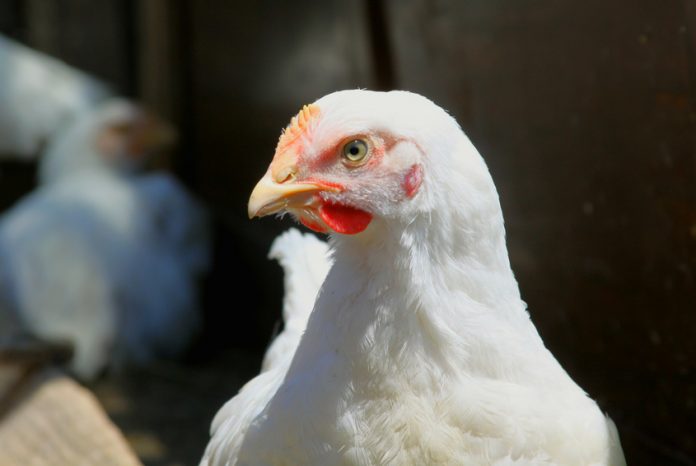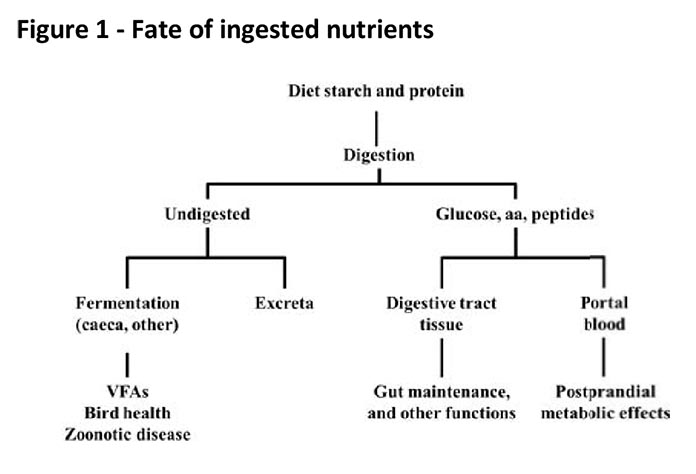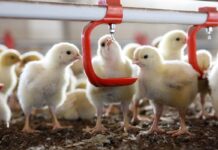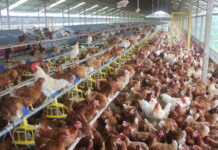
In poultry formulation and production of feed has evolved extensively in the last century with the identification of required nutrients, and subsequent and continuing definition of the bird’s nutrient requirements and this evolution has resulted in improved efficiency of poultry production as increasingly more precise methods of feeding are developed. The research associated with this paper focuses on the continuation of this evolution by examining aspects of precision feeding of poultry. In particular, this research focuses on the extent, rate and location of nutrient (energy, amino acids) digestion, and how this relates to bird production efficiency, health and welfare.
Traditionally, nutritionists have focused on ingredient and diet digestibility by measuring nutrients remaining in either the excreta or the contents of the terminal end of the small intestine. However, some research suggests that the kinetics of nutrient digestion and absorption are also important in efficient animal production. Furthermore, understanding the characteristics of what is not digested may also be important in bird wellbeing in the era of antibiotic free production.
Site and extent of nutrient digestion and absorption – why does it matter?
The fate of ingested feed is shown in Figure 1 along with resulting potential effects. Rate and site of nutrient digestion impact the distribution of these effects. After consumption, hydrolysis of feed to absorbable nutrients occurs as a result of the actions of moistening, pH changes, presence of digestive enzymes, and other pancreatic, liver and digestive tract secretions. Much of the digestion and absorption of nutrients occurs in the anterior portions of the small intestine (SI), particularly the duodenum and jejunum, but absorptive capacity is also present in the terminal ileum. Nutrients are transported through the apical membrane into the enterocyte cytoplasm, where they can be metabolized or pass through the basolateral membrane to the portal blood system for systemic metabolism. Undigested material from the SI can either be excreted via the colon and cloaca, or content that is small and/or soluble can enter the caeca and be fermented by an extensive bacterial population. Water and mineral absorption, as well as products of fermentation (i.e. short chain fatty acids (SCFA)), are absorbed in the caeca.
 The nutritional profile of feed can thus be broken down into those nutrients that are digested and absorbed in the SI, those having the potential to benefit or harm the host via fermentation, and undigested material lost as excreta. Nutrients absorbed in the SI can further be differentiated based on their first pass utilization by digestive tract tissue (DTT) or absorption into the portal blood system for distribution to the remainder of the body. Even further definition of nutrients can be based on the kinetics of nutrient digestion and the site of absorption in the SI.Nutrients that are absorbed in the SI can either be used by DTT or absorbed into the portal blood system. Because of its high metabolic profile, DTT accounts for up to 25 to 35% of whole body protein turnover and energy expenditure despite its relatively small proportional size (4 to 6% of body weight). The high metabolic demand relates not only to its nutrient digestion and assimilation role, but also to its importance as a physical and immunological barrier against enteric toxins and the vast microbial community including pathogens. The location of first pass utilization is affected by rate of digestion and more rapidly degraded starch and protein would have more impact on DTT in the anterior portion of the SI (duodenum and jejunum). If digestion is rapid and relatively complete, this would reduce first pass utilization in the distal SI and result in this tissue relying on the arterial supply of nutrients.
The nutritional profile of feed can thus be broken down into those nutrients that are digested and absorbed in the SI, those having the potential to benefit or harm the host via fermentation, and undigested material lost as excreta. Nutrients absorbed in the SI can further be differentiated based on their first pass utilization by digestive tract tissue (DTT) or absorption into the portal blood system for distribution to the remainder of the body. Even further definition of nutrients can be based on the kinetics of nutrient digestion and the site of absorption in the SI.Nutrients that are absorbed in the SI can either be used by DTT or absorbed into the portal blood system. Because of its high metabolic profile, DTT accounts for up to 25 to 35% of whole body protein turnover and energy expenditure despite its relatively small proportional size (4 to 6% of body weight). The high metabolic demand relates not only to its nutrient digestion and assimilation role, but also to its importance as a physical and immunological barrier against enteric toxins and the vast microbial community including pathogens. The location of first pass utilization is affected by rate of digestion and more rapidly degraded starch and protein would have more impact on DTT in the anterior portion of the SI (duodenum and jejunum). If digestion is rapid and relatively complete, this would reduce first pass utilization in the distal SI and result in this tissue relying on the arterial supply of nutrients.
The efficiency of nutrient use for DTT functions in first pass and arterial sources is not clear. It can be speculated that slowly degraded nutrients may benefit DTT metabolism in the distal sections of the SI. In terms of energy for DTT maintenance, glutamate and glucose are both substrates, and although more effective together, this suggests that either slowly digested starch or protein could serve this role if present in the distal SI.
Nutrients absorbed into the portal blood system are distributed for use in a wide range of roles in the body. Absorption also results in a number of physiological effects designed to effectively use these nutrients. The degree of hormonal response to nutrients and consequential effects on bird metabolism is related to the speed of nutrient absorption and this effect is larger in meal fed birds like broiler breeders. Therefore, the kinetics of nutrient (glucose, amino acids) digestion and absorption in the avian gastrointestinal tract (gut) has the potential to impact the growth and reproduction of these animals via post-prandial effects.
Undigested components of the diet at the terminal ileum can either be directly voided or portions can be fermented in the ileum, caeca and colon. It is generally conceded that the caeca are the primary site of fermentation and only small and/or soluble particles will enter the caeca. Therefore, the degree of caecal fill will be determined by characteristics of the diet and resulting digesta. Although it is unlikely that the caeca make a large contribution to the energy requirements of commercial chickens or turkeys, the caeca are considered to play an important role in bird health and are also the predominant reservoir for Salmonella and other zoonotic organisms. The nature of fermentation in the caeca and elsewhere can affect the bacterial profile and activity in a manner which could control colonization by Salmonella. In the case of carbohydrate fermentation, the bacterial profile could be shifted in favour of beneficial species and/or increase the production or proportion of SCFA that lower pH, inhibit growth of Salmonella and other enterobacteriaceae, regulate expression of Salmonella virulence factors, and modulate mucosal immunity. As noted above, the nature of material entering the caeca will affect fermentation and it is well recognized that fermentation of carbohydrates and protein result in different end products.
A common belief is that slowly or poorly digested protein can lead to detrimental changes in the lower gastrointestinal tract due to its fermentation by putrefactive organisms. When used as an energy source, bacterial metabolism of amino acids from unabsorbed proteins yields a number of fermentation products (e.g. ammonia amines, phenolic and indolic compounds, H2S, dimethyltrisulphide). In contrast to SCFA, protein fermentation products have been primarily associated with toxigenic and carcinogenic impacts on the intestinal epithelium including increased expression of inflammatory markers and reduced barrier function. Identification of a consistent means of affecting caecal function in a positive manner, to yield desirable end products capable of improving nutrient metabolism, barrier function and pathogen prevalence, would have significant implications for production and food safety for the poultry industry.
With the above background, the following sections will demonstrate areas of our research that relate to the rate and extent of digestibility in poultry.
Broiler breeders and slowly digested starch
Feed restriction is applied to broiler breeders during rearing and laying phases to maintain body weight target essential for good health and production. A common practice is to feed on an every other day basis (EOD, every 48 h) during the rearing phase to achieve body weight goals; as a consequence birds are hungry and without feed for considerable period of time, which might have a negative impact on growth and uniformity. The rate of starch digestion may affect hunger and therefore this experiment compared feeding diets containing equal starch content, but based on slowly (pea) or rapidly (wheat) digested starch to broiler breeder pullets. Diet had only a minor effect on growth indicating that the feeds were formulated to a similar nutrient content. However, uniformity was improved by feeding a pea pea-based diet. Digesta content and gut mass were also increased by feeding the pea based diet over the 48 h period between feeding. After feeding, the post prandial glucose peak was lower for pullets fed the pea based diet and these birds also had smaller livers and less fat content. In agreement with this finding, expression of liver enzymes involved in fat synthesis were reduced by feeding a pea rather than wheat based diet.
These finding indicate that feeding a pea based diet (slowly digested) resulted in a reduced degree of nutrient storage and re-utilization in feed restricted broiler breeder pullets during the post-prandial phase. Pullets fed a pea based diet expressed increased comfort and resting behavior, and reduced foraging and walking behavior during the off-feed day (24–48 h) and had reduced serum levels of non-esterified fatty acids and -hydroxybutyrate-HBA (indicators of fasting) after 26 and 28 h post-feeding, respectively. Overall, both physiological and behavioral indicators suggested increased satiety in feed restricted broiler breeder pullets when fed a pea-compared with a wheat-based diet.
Starch digestibility and ad-libitum fed poultry
Previous research has found that feeding a portion of slowly digested starch to poultry improves performance and in particular feed efficiency. In some cases, the results were confounded by the nature of the ingredient being fed. To avoid this situation, semi-purified rapidly (RDS – wheat) and slowly digested (SDS – pea) starches were used in diets formulated to be iso-caloric and iso-nitrogenous, and differ only in the proportion of the two starch types. Six ratios of RDS to SDS (100/0, 80/20, 60/40, 40/60, 20/80 and 0/100) were each fed to broilers and laying hens in separate experiments. For broilers, the best growth (numerically) and feed efficiency (statistically) were achieved by the 80/20 diet.
All levels of SDS increased breast meat yield and reduced skin weight, an indication of reduced fat levels. In laying hens, increasing inclusion of SDS in diets increased feed intake linearly, while hen-day egg production, feed efficiency (g of feed/g of egg) and egg specific gravity responded in a quadratic fashion with highest, lowest and highest values achieved for the 80/20, 40/60 and 60/20 diets, respectively. Starch type did not affect egg weight or hen feathering.
Turkey research used diets containing four ratios of RDS to SDS (100/0, 85/15, 70/30 and 55/45). Hen body weight at 77 days of age was affected by diet with the highest weight for the 70/30 treatment; in contrast the best feed efficiency resulted from feeding the 100/0 treatment. Breast muscle yield was numerically highest for all treatments containing SDS, but in contrast to broiler chickens, fat level was also higher in these treatments. In conclusion, starch digestion rate affected all classes of poultry, but the results were not exactly the same. The effect on meat yield fat content in broiler chickens and turkeys is of interest and may be related to a post-prandial effect on bird metabolism. How that occurs in birds that eat small meals frequently requires investigation.
Protein digestibility and level in broiler diets
Poorly digested protein has been suggested to result in poor broiler health and performance because of the negative effects of protein fermentation. To test this suggestion, we evaluated the effects of three dietary protein levels (24, 26 and 28%) each with low or high indigestible protein content (LIP, HIP) on broiler performance and health from 0 to 32 days of age. All diets met broiler grower nutrient specifications, contained no medication and were formulated to the same level of digestible methionine. Wheat was the cereal grain in all diets and protein sources in the LIP diets were soybean meal (SBM) and fish meal, while HIP diets used SBM, corn gluten meal, porcine meal and corn distillers dried grains with solubles. The floor housed broilers were vaccinated on feed and waterers with Coccivac-B52 (Merck Animal Health) on day 5 and kept under high humidity conditions to encourage the development of disease. Body weight at 32 d was affected by protein content (26>28 with 24% intermediate), protein indigestible fraction (LIP>HIP) and gender (M>F). Feed to gain ratio (mortality corrected) for the overall trial was affected by protein level (24>26=28) and protein indigestible fraction (HIP>LIP).
In conclusion, dietary protein level and the proportion of indigestible protein can affect performance when broilers are fed nutritionally adequate diets. Total flock mortality (10.75%) was divided into infectious, non-infectious heart associated, non-infectious skeletal, other, and unknown categories representing 7.38, 0.89, 0.12, 0.48 and 1.89% of broilers placed, respectively. Infectious mortality was grouped into yolk sac infection, coccidiosis (CO), necrotic enteritis, and systemic infection (SI) subcategories representing 0.55, 0.69, 2.04, and 4.09% of broilers placed, respectively. Diets with LIP increased infectious mortality (9.11 vs 5.69%), associated with increased CO (1.03 vs 0.39%) and SI (4.98 vs 3.23%) compared with HIP. More males died than females (13.84 vs 7.69%) from overall infectious causes (9.62 vs 5.18%), as well as CO (1.01 vs 0.41%) and SI (5.43 vs 2.79%). The results are counterintuitive in that it might be expected that LIP diets (high digestibility) would reduce mortality and the increased crude protein level would increase mortality. It would be premature to conclude that low protein indigestibility promotes disease. A more logical explanation is that the impact bird health is protein source dependent.
From the Proceedings of the 11th Turkey Science and Production Conference

















